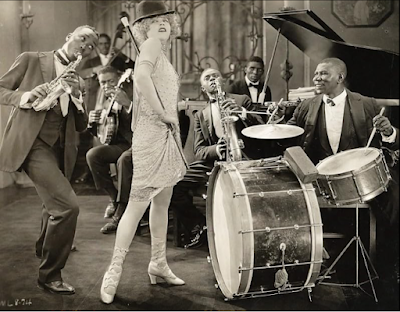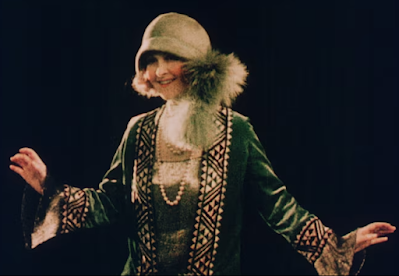I heard it through the grapevine, how much longer can
you be mine…? is a song Marvin Gaye sang and he could indeed have been
addressing the transient nature of physical media as well as his love for Tammi
Tyrell. Grapevine video, who for the last few decades have been issuing
public domain silent films in various degrees of quality, most unrestored, has decided to cease its current
approach. Founder Jack Hardy retiring, his colleague Jason, will
continue the brand as the home for Kickstarter transfers and restorations
whilst running the current stock down - the site still seems fully functional, but this is no time to dither if they have something you want!
Whilst this is not the greatest of news for the seeker of
rare silent film grooves, and it did precipitate a rush to obtain some of the
finite stock on their site, it does leave us with another route to market for
higher quality transfers from archive film along with those offered by Ben
Model, Ed Laruso and Red Mill Films. This model has also already been running
at Grapevine and the peak Colleen Moore vehicle, Twinkletoes (1926), was one of
those I backed, always keen for, erm, more Moore.
Coming to any film entitled Twinkletoes did give
me pause, the title alone red-flagging what sounds like a feel-good rags to
riches story based on a happy-go-lucky dancer with natural-born talent? Well…
think again you cynical old fool, keep your post-post-modern toy-comedies and
post-nuclear doom-dramas, this film is the kind of small-world drama that Greta
Gerwig would love albeit one with a linear narrative that might confuse
Christopher Nolan… it is filmed on celluloid though mate.
 |
| Colleen Moore and Tully Marshall |
The superpower here is, of course Colleen Moore and time
after time she rises above the source material to impress the viewer with her
gleeful zest and supernatural energies. Despite the twee title, Twinkletoes
is actually more at the dramatic end of her films, sure there are playful
street fights, high hopes and winsome stainless steel melting smiles, but
there’s also infidelity, violent confrontations with sad drunken competitors,
crime, betrayal and dark motivations.
Perhaps more than anyone else since young Pickford does
Moore represent everywoman in her twenties’ heyday with an incredible audience
connection, created by her sharp-eyed expression, physical dynamism and looks
that whilst they lack the style and sexuality of those other bob-wearers Clara
and Louise, can be easily as pretty as the part demands. Colleen’s ordinary in
an extraordinary way and as tough as the audience dream of being too. An avatar
of ambition and affection rivalled by few others.
Perhaps the most shocking thing here is seeing Moor on point,
I wasn’t aware of her dance background and that moment speaks not so much of
showbusiness as ten thousand hours of pain and dedication; a tailor-made woman
determined almost beyond reason to dance in those grey shoes, to stardom on
stage or on screen. A multi-tasking master.
 |
| Colleen Moore on point and possibly wearing red ballet shoes. |
Directed by Charles Brabin based on Thomas Burke’s novel Twinkletoes:
A Tale of the Limehouse (1918). This was Burke’s first publishing success
at the time and another of his tales from the collection, “The ‘Chink’ and
the Child” (ow, apologies) had already formed the basis, of course it had,
of DW Griffith’s Broken Blossoms (1919). Burke was born in Clapham and
having lost his father when just a baby, had lived in Poplar with his uncle and
attended a home for middle-class boys who were “respectably descended but
without adequate means to their support…” He was attacked by the Times Literary
Supplement as a “blatant agitator” but gained a reputation as “the laureate of
London’s Chinatown”.
Brabin’s sets certainly convey the cramped poverty of the
East End 5,000 miles away and the opening brings most of the central characters
together in one fluid sequence… we find bare-knuckle star Chuck Lightfoot
(Kenneth Harlan) striding through Limehouse taking all the congratulations for
his latest victory. None of this is good enough for his dipsomaniacal wife Cissie
(Gladys Brockwell) and a conflagration gradually escalates watched from above
by Dad Minasi (Tully Marshall) as he cleans windows above. As the police arrive
to break things up, young Twink (Moore) distracts everyone with an impromptu
jig… and as the crowd dissipates, she derides both Chuck and Cissie for their
bad behaviour, the former surprisingly willing to listen to the lass.
Twink and her father return home and there’s much
affection between the two with the young woman aiming to take after her mother
who had been a great dancer and the original “Twinkletoes” … a poster outside
still stands testimony to her popularity, even as one of the locals, doubts his
young friend can be that dancer. It’s Colleen Moore you fool, of course she can.
 |
| Best of friends, Colleen and Kenneth Harlan |
Luckily the film doesn’t focus on the inevitability of "Twinkletoes Two" but her love triangle with Chuck and his no-good wife, Cissie. This
is quite a daring course for a film of this time and makes for a much more
interesting drama especially as we see the lovesick boxer, removed of his
physical prowess by his compromised marriage and the tenderness of his feelings
for Twink; it’s an interesting role for the big lunk and he excels with what
are no doubt big old Irish eyes.
Cissie herself is a real piece of work, another juicy
role, and when she can’t beat Twinks in a fist fight or battle of wills – let
alone a dance off – she is cunning and reports the dancer’s father to the
police. No one likes a grass Cissie but I guess you’re not that keen on
yourself either… Dad has, of course, been keeping his criminal side-lines away
from Twinks as he tries to wrap up his obligations; now it’s all in danger of
collapsing in on him and his pure-hearted daughter.
Cue the music, start the dance!
OK, this is hardly Pabst or Sjostrom but it is a very
well-directed film that builds up a decent head of suspense and dramatic
tension, from the bit set piece riot at the start to Twink’s stage triumph and
the dark betrayals of Cissie. Produced by her husband John McCormick and
distributed through Moore's resident studio First National, it shows her
dramatic chops which they rotated with comedy fare like Why Be Good? She had
the range and reminds me a little of a silent Anna Kendrick, quirky but
interesting and with additional talents; sure, Anna can sing though but I doubt
she can do ballet…
The Grapevine Blu-ray which is a transfer from 16mm materials in decent if not full restoration clarity. We should be grateful we have it at all though, these are tough times for content and there’s still a certain satisfaction in collating your own home library; you can’t take it with you but you can rewatch it and, should the family agree, take it with you in an outsized coffin buried at the base of a modest garden pyramid…
Anyway, if you want to grab a copy it's available on their website here.



















.JPG)
%20look.JPG)































+colour.png)





